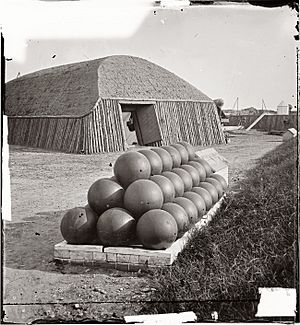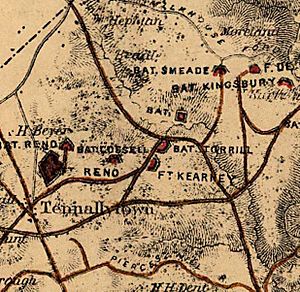Fort Kearny (Washington, D.C.) facts for kids
Quick facts for kids Fort Kearny |
|
|---|---|
| Part of the Civil War defenses of Washington, D.C. | |
| Tenleytown, District of Columbia | |

An ammunition magazine similar to those built at Fort Kearny.
|
|
| Coordinates | 38°57′19″N 77°03′58″W / 38.955254°N 77.066098°W |
| Type | Earthwork fort |
| Site history | |
| Built | 1862 |
| Built by | 15th New Jersey Voluntary Infantry Regiment and the United States Army Corps of Engineers |
| In use | 1862–1865 |
| Materials | Earth, timber |
| Demolished | 1866 |
| Battles/wars | American Civil War |
| Garrison information | |
| Garrison | Two companies, 7th New York Heavy Artillery Regiment |
Fort Kearny was a special fort built during the American Civil War. It was part of a big defense system around Washington, D.C.. This fort was near Tenleytown in Washington, D.C. It helped protect the area between Fort Reno and Fort DeRussy. The fort was named after Philip Kearny, a brave Union Army general. He sadly died in a battle on September 1, 1862. Three smaller gun areas, called Battery Rossell, Battery Terrill, and Battery Smead, also helped protect the fort.
Template:TOC limit=3
Contents
Building Fort Kearny
Building the fort started in the summer of 1862. It was discovered that the guns at Fort Reno and Fort DeRussy could not cover all the hilly land between them. So, a new fort was needed to fill this gap. This new fort became Fort Kearny.
On September 4, 1862, soldiers from the 15th New Jersey Volunteer Infantry Regiment began working on the fort. They were chosen to do the first construction. The fort was named "in honor of the gallant General who had fallen." The soldiers also cut down trees and built new military roads. They even built earth walls for protection.
The area around the fort was once very pretty. But the war changed it. Trees were cut down for miles around. This was done so soldiers could see far away without anything blocking their view. The cut trees were used to make barriers called "abatis." Many houses were left empty, and fences were burned.
After the fort was built, the 15th Regiment helped set up the big guns. On September 29, 1862, other workers arrived to help. The 15th New Jersey Regiment then left Fort Kearny.
Building the fort was slow because there were not enough workers. In December, the 113th New York Volunteer Infantry Regiment was ordered to help. But reports said that only a few of their 150 men actually worked.
Despite these problems, by Christmas 1862, the fort was ready. Reports said Fort Kearny was in a great spot. It connected Forts Pennsylvania (Reno) and DeRussy. It could see the Broad Branch valley and fire its guns with the other forts. It had powerful weapons and safe places for ammunition.
A smaller gun area, called Battery Rossell, was also built nearby. It had space for eight field guns and a strong powder magazine. Battery Rossell was named after Major Nathan B. Rossell. He was killed in a battle on June 27, 1862.
In 1864, two companies of the 7th New York Heavy Artillery Regiment guarded the fort. A report from May 1864 said there were 298 soldiers at the fort. This was a full group of soldiers. However, the report also noted that their training needed to be better.
The fort itself was in excellent condition. The same inspection found many powerful guns. These included three 24-pounder guns and three 32-pounder guns. It also had a large howitzer and three rifled guns. The powder magazine was dry and in good order. All the ammunition was in full supply and ready to use.
Fort Kearny's Guns and Size
Here is a look at the guns and condition of Fort Kearny and its supporting batteries:
- Battery Terrill – This battery had 7 guns. Today, some parts might be found north of Fort Kearny. It is located at 3001 Garrison Street, near the Peruvian Embassy. There is no marker there.
- Fort Kearny – This fort had 11 guns. It was located between Forts Reno and DeRussy, at 4900 30th Place. The fort's outer wall was about 320 yards long. No parts of the fort remain today, and there is no marker.
- Battery Rossell – This battery had 8 guns. It was located between Forts Reno and Kearny, at Fessenden Street and Connecticut Avenue. No parts of it remain, and there is no marker.
Battle of Fort Stevens
In July 1864, Confederate forces attacked the forts around Washington, D.C. This attack was led by Jubal Early, a Confederate general. He hoped to take pressure off General Robert E. Lee's army, which was fighting in Virginia.
Early's soldiers took positions around Washington. His headquarters were near what is now Chevy Chase. Other Confederate groups spread out across the hills. Fort Kearny itself was not directly attacked. But people worried that Confederate soldiers might try to sneak through the hills near Tenleytown.
On July 11, soldiers from the 22nd Regiment of the Veteran Reserve Corps took positions in trenches in front of Fort Kearny. At 7:30 p.m., Confederate soldiers were seen building their own defenses north of the forts.
Six companies of the 22nd Regiment were sent forward. They were ordered to help the Union skirmishers (small groups of soldiers) who were fighting north of the forts. At 6 a.m. on July 12, these companies moved north. They cleared out Confederate sharpshooters who had been bothering Union forces all night. By 7:00 a.m., another regiment arrived at Fort Kearny. They took over from the 22nd Regiment, which then moved further north.
These few Confederate sharpshooters were the closest any Confederate force got to Fort Kearny's guns. Most of the fighting happened further north and east, near Fort Stevens and Fort DeRussy.
The 15th New Jersey Volunteers Return
On July 9, 1864, the 15th New Jersey Volunteer Infantry Regiment, which had built Fort Kearny, was called away from fighting in Virginia. They boarded steamboats on July 11 and sailed towards Maryland.
On the evening of July 11, General Early tried to quickly attack Washington. There were not enough soldiers to stop him. Only a few thousand soldiers were gathered. They were mostly cavalry and men from other departments. They were not well organized. People in Washington worried the city might be captured.
But Early hesitated. "Before him was the greatest prize of the war." He paused for a night, and his chance was gone.
On July 12, at 11 a.m., the 15th New Jersey Regiment arrived in Washington. Citizens and officials welcomed them as heroes. They marched through the city, with flags flying, as people cheered. They heard cannons booming and quickly moved towards the fighting. They were ordered to Fort Stevens to meet General Early's attackers.
Around 4 p.m., the guns of Fort Stevens fired on the enemy. Union soldiers attacked and pushed the Confederates back. This fighting caused about 300 casualties for both sides.
As night fell, Early's forces began to retreat. On July 13, the Union soldiers started chasing them. The 15th New Jersey Regiment left Fort Stevens at 4 p.m. They passed behind Forts DeRussy, Kearny, Reno, and Pennsylvania. They knew this area well. Fort Kearny looked much the same as when they left it. It had more guns and better connections to other forts. Comfortable barracks had also been built for the soldiers.
The next day, Early crossed the Potomac River. This exciting part of the war ended.
After the Confederate attack, a new report suggested ways to improve the forts. For Fort Kearny, the only idea was to add four field guns to Battery Terrill. This would help protect the fort from certain angles.
After the War
After the Civil War ended on April 9, 1865, there was no longer a need for so many forts around Washington. Experts suggested dividing the forts into three groups. Some would stay active, some would be kept in reserve, and some would be completely abandoned. Fort Kearny was in the group meant to be kept in reserve.
However, due to budget cuts, Fort Kearny was abandoned instead. The land was sold. Today, there are no signs of the fort left. The area is now a neighborhood called Forest Hills. It is located between Fort Reno Park and Fort DeRussy in Rock Creek Park.
Where Was Fort Kearny?
By comparing old maps with modern maps, we can pinpoint the fort's location. It was in the 4900 block of 30th Place. The shape of Fort Kearny, as drawn in 1862, helps confirm its exact spot.
Images for kids




